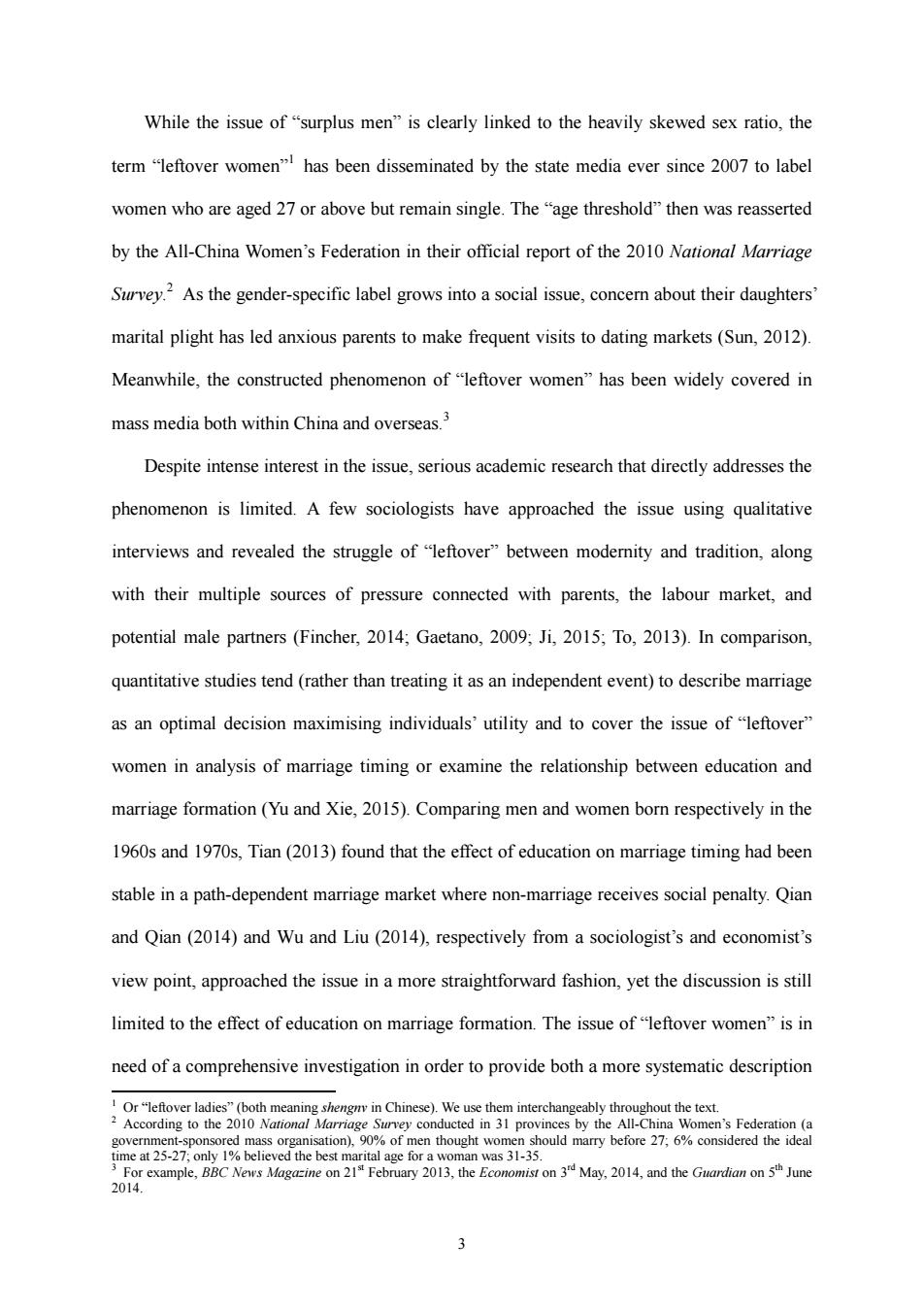正在加载图片...

While the issue of"surplus men"is clearly linked to the heavily skewed sex ratio,the term "leftover women"has been disseminated by the state media ever since 2007 to label women who are aged 27 or above but remain single.The "age threshold"then was reasserted by the All-China Women's Federation in their official report of the 2010 National Marriage Survey.2 As the gender-specific label grows into a social issue,concern about their daughters' marital plight has led anxious parents to make frequent visits to dating markets(Sun,2012). Meanwhile,the constructed phenomenon of"leftover women"has been widely covered in mass media both within China and overseas.3 Despite intense interest in the issue,serious academic research that directly addresses the phenomenon is limited.A few sociologists have approached the issue using qualitative interviews and revealed the struggle of"leftover"between modernity and tradition,along with their multiple sources of pressure connected with parents,the labour market,and potential male partners (Fincher,2014;Gaetano,2009;Ji,2015;To,2013).In comparison, quantitative studies tend(rather than treating it as an independent event)to describe marriage as an optimal decision maximising individuals'utility and to cover the issue of "leftover" women in analysis of marriage timing or examine the relationship between education and marriage formation(Yu and Xie,2015).Comparing men and women born respectively in the 1960s and 1970s,Tian(2013)found that the effect of education on marriage timing had been stable in a path-dependent marriage market where non-marriage receives social penalty.Qian and Qian (2014)and Wu and Liu (2014),respectively from a sociologist's and economist's view point,approached the issue in a more straightforward fashion,yet the discussion is still limited to the effect of education on marriage formation.The issue of"leftover women"is in need of a comprehensive investigation in order to provide both a more systematic description Or"leftover ladies"(both meaning shengm in Chinese).We use them interchangeably throughout the text. 2 According to the 2010 Narional Marriage Survey conducted in 31 provinces by the All-China Women's Federation (a government-sponsored mass organisation),90%of men thought women should marry before 27;6%considered the ideal time at 25-27;only 1%believed the best marital age for a woman was 31-35. 3 For example,BBC News Magaine on21 February 2013,the Economist on 3 May,2014,and the Guardian on 5 June 2014. 33 While the issue of “surplus men” is clearly linked to the heavily skewed sex ratio, the term “leftover women”1 has been disseminated by the state media ever since 2007 to label women who are aged 27 or above but remain single. The “age threshold” then was reasserted by the All-China Women’s Federation in their official report of the 2010 National Marriage Survey. 2 As the gender-specific label grows into a social issue, concern about their daughters’ marital plight has led anxious parents to make frequent visits to dating markets (Sun, 2012). Meanwhile, the constructed phenomenon of “leftover women” has been widely covered in mass media both within China and overseas.3 Despite intense interest in the issue, serious academic research that directly addresses the phenomenon is limited. A few sociologists have approached the issue using qualitative interviews and revealed the struggle of “leftover” between modernity and tradition, along with their multiple sources of pressure connected with parents, the labour market, and potential male partners (Fincher, 2014; Gaetano, 2009; Ji, 2015; To, 2013). In comparison, quantitative studies tend (rather than treating it as an independent event) to describe marriage as an optimal decision maximising individuals’ utility and to cover the issue of “leftover” women in analysis of marriage timing or examine the relationship between education and marriage formation (Yu and Xie, 2015). Comparing men and women born respectively in the 1960s and 1970s, Tian (2013) found that the effect of education on marriage timing had been stable in a path-dependent marriage market where non-marriage receives social penalty. Qian and Qian (2014) and Wu and Liu (2014), respectively from a sociologist’s and economist’s view point, approached the issue in a more straightforward fashion, yet the discussion is still limited to the effect of education on marriage formation. The issue of “leftover women” is in need of a comprehensive investigation in order to provide both a more systematic description 1 Or “leftover ladies” (both meaning shengnv in Chinese). We use them interchangeably throughout the text. 2 According to the 2010 National Marriage Survey conducted in 31 provinces by the All-China Women’s Federation (a government-sponsored mass organisation), 90% of men thought women should marry before 27; 6% considered the ideal time at 25-27; only 1% believed the best marital age for a woman was 31-35. 3 For example, BBC News Magazine on 21st February 2013, the Economist on 3rd May, 2014, and the Guardian on 5th June 2014